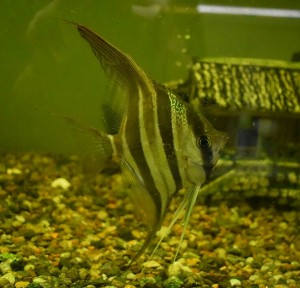
How can you tell an altum angelfish from an angelfish?
 Pellegrin first recognized Pterophyllum altum as a distinct species in 1903, and it has only been found in the Rio Orinoco in Venezuela. P. altum differs physiologically from P. scalare in a number of ways, the most noteworthy of which being the presence of more soft dorsal and anal fin rays. Due to its enormous dorsal and anal fins, more vertical form, and drastically concaved forehead area, it has an unmistakably regal appearance. Only a few times has P. altum been bred in captivity. As a result, all of the species seen in retail aquariums had to be imported.
Pellegrin first recognized Pterophyllum altum as a distinct species in 1903, and it has only been found in the Rio Orinoco in Venezuela. P. altum differs physiologically from P. scalare in a number of ways, the most noteworthy of which being the presence of more soft dorsal and anal fin rays. Due to its enormous dorsal and anal fins, more vertical form, and drastically concaved forehead area, it has an unmistakably regal appearance. Only a few times has P. altum been bred in captivity. As a result, all of the species seen in retail aquariums had to be imported.Despite the fact that both wild P. altum and P. scalare have reddish-black patches on their dorsums, only the altum has a second dark head bar that runs between the dark bar that goes through the eye and the bar that begins at the base of the first dorsal spines. The altum's unpaired fins lack the brilliant markings observed on P. scalare's unpaired fins. The mouth pieces of P. altum are considerably further out from the front of the head than those of P. scalare. You'll also notice that altums have an odd "yawning" habit. If you look closely, you'll see that their lips are substantially larger when fully expanded than they appear while closed.
While selecting your altums, you may notice that the specimens in the shop's aquariums seem a little ragged. Torn or split fins and missing scales are the most prevalent problems, which are caused by the rigors of transportation, internal fighting, or predators in the wild. A condition known as black spot may be present in certain instances. It will seem as though the sick fish has been sprayed with pepper. The spots on the fish's skin are really encysted parasites that have burrowed into the skin of the fish. In the wild, parasites employ fish as intermediate hosts, where they can only multiply and cause harm to the insides of fish-eating birds that consume parasitized fish. The parasites are usually harmless to the fish and difficult to spread to other fish.
Because wild fish, in particular, are often infested with parasites, keeping a quarantine tank for any new species before releasing them into existing community aquariums is critical. My quarantine tank is a 20-gallon aquarium with a cover and a sponge filter for biological filtration, both controlled by a reliable air pump. I inspect the water to determine whether it has been dechlorinated. Keep in mind that altums are very sensitive to high levels of ammonia and nitrite in their water. It is impossible to overestimate the value of adequate biological filtration.


